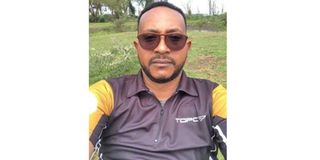
Elijah Obuong, Brian Oduor, Benjamin Imbai and Jack Onyango, who went missing on April 19, 2021.
| PoolNews
Premium
Unravelling mystery, return of Kenya’s death squads
On the spot where Bashir Muhamud’s vehicle was torched by his killers, only the burnt grass patch remains. The fire, so intense, its dark smoke billowing into the skies, had melted what it could of the new Range Rover, registration number KCQ 007P. The killers, brutal and vicious, did not leave anything to chance.
As of this writing, nobody knows who killed the flamboyant Somali-American engineer-turned-tenderpreneur, who had been winning multi-million-shilling contracts in Kenya, shortly after he left Mialle 72 Lounge in Lavington, Nairobi.
More intriguing is how his body ended up 130 kilometres away, in Kerugoya’s River Nyamindi, naked and with deep cuts after he was abducted on May 13.
Among the questions being raised is who could have had the time, resources and muscle to kidnap a fully grown man, burn his SUV some 30 kilometres from where it was last seen, remove the vehicle’s tracker, strangle the man and dump his body dozens of kilometres in another county when a police search was still underway.
“In this case there are only two suspects – police or criminal gangs,” says Peter Kiama, the executive director of The Independent Medico-Legal Unit.
The emergence of a possible killer squad – similar to Brazil’s Esquadrao da Morte – or some shadowy vigilante hitmen is troubling because the killings follow a similar pattern: abduction, torture and bodies found in rivers. Interestingly, these are not the regular gunmen riding pillion on motorcycles.

Mohamud Bashir Mohamed.
Bashir’s death was similar to those of Benjamin Amache Imbai, Oduor Brian, Jack Anyango Ochieng and Elijah Obuong. The four were picked up from a restaurant in Kitengela on April 19 by unknown people and were never seen alive again.
Imbai’s and Obuong’s bodies were later found floating on a river in Murang’a, 87 kilometres away. And as in Bashir’s case, a postmortem exam later revealed that they had been strangled.
While Bashir appears to have had dalliances with top business and political honchos in Kenya, our investigations into the Kitengela quartet of Imbai, Odour, Ochieng and Obuong indicate that they were not only hardcore criminals but were also being protected by some officers from the Buru Buru Police Station – and that they were living on borrowed time as several of their accomplices had been killed.
The group, we have established, relocated to Nairobi in 2018 following their involvement in a spate of robberies in the coastal region.
Killer squad
So, who wanted them out of the way, and is the killer squad the same that eliminated Bashir?
For Bashir, the case started on May 15, when residents of Ole Maroroi village, on the road to Suswa in Narok County, stumbled on the burning wreckage of the SUV, just off the road.
With Bashir’s family searching for him, the wreckage of his vehicle offered a clue on what had happened to him. But two days after officers from the station visited the site, and ostensibly left to call scene-of-crime detectives, the Range Rover wreckage disappeared, about the time his body was found in the Kerugoya Hospital mortuary, after it was retrieved from River Nyamindi.
While they were supposed to secure the scene, as investigations began, this never happened. For two days, the wreckage was left unattended and two days later, locals said, two men came to collect it.
“They had a Mitsubishi Canter and a small car. They stayed here for a long time. We thought that they were police officers or that the owner of the car had sent them to pick it up, and so nobody really bothered to know who they were,” said Joel Sunkuli, who lives near where the car was found.
The Nation learnt that the first report about Bashir’s car being found was made to the Kibiku Police Station by herders at about 7am on May 15. Sources in the police service have told us that the police station commander circulated a signal and informed his seniors about the wreckage.
While the Nation cannot say who killed Bashir – as investigations are still underway – the police seem to have made clear blunders, some errors of omission and commission, that raise doubts about whether they were interested in pursuing the killers.
The whereabouts of the wreckage of Bashir’s vehicle are still unknown. Even more significant, the Homicide Department of the Directorate of Criminal Investigations (DCI) has not visited Ole Maroroi to see what sort of evidence they can find or to reconstruct the scene from whatever was left behind by the men who picked up the remains of the vehicle.
Range Rover
We have established that Bashir may not have been killed at Ole Maroroi, where his smoldering vehicle was found before its remains were carted off. We also now know that the tracker for the Range Rover – after he was seen driving off from Miale Lounge with the guards waving him goodbye, and which would have offered clues on what happened to him – was switched off less than 10 minutes after he left the lounge in Lavington, Nairobi.
During a visit last week to the site where the wreckage of the vehicle was found, the Nation was able to identify what looked like the remains of two burnt-out mobile phones. Also on the scene was a partly burnt rearview camera, shattered glass and burnt seats.
The big question is if journalists with no police investigative skills can identify such investigation lapses in a homicide that has attracted a lot of attention, why is the State unable to do so? Most importantly, who is this kidnapping and strangling men who have dealings with elements within the State and cannot be found?
The biggest clue to solving such murders is trying to find out who benefits when someone has been eliminated from the world. According to intelligence sources, Bashir was wiring millions of shillings to influential people in Somalia. The money was then finding its way to extremist groups, some of whom were attacking Kenya.
This theory doesn’t, however, provide a clue on why specifically the businessman was killed, because his company was receiving tenders worth billions of shillings from the Kenyan government. Bashir was a director at Infinity Development Ltd and it is unthinkable that the government was knowingly doing business with a criminal or had just found out about his background.
A search at the Registrar of Companies shows that Bashir owns 200 shares in Infinity Development.
But if Infinity Development is engaged in clean business, why was one of its biggest shareholders and directors killed in such a gangland-style murder? It is said that Bashir’s first wife, who lives in the United States, is linked to intelligence officials in Somalia.
With no evidence on who he could have wronged, in the course of doing business or in his social life, the killing of Bashir is an indication of the presence of a killer squad – either for hire or as a non-state actor.
His killers also carried out their job with so much precision that with the bungling of the investigation it will be hard to find out who was responsible.
Conspicuously, the United States, which usually reacts dramatically to the killings of its citizens abroad, has been loudly silent on Bashir’s killing.
Kitengela – with its sprawling middle-class houses and flats that are good hideouts for criminals – seems to be offering the perfect killing fields because of the swaths of unoccupied land and savanna bushes that give cover to criminals and denizens of the wild.
It was in Kitengela that Imbai, Odour, Ochieng and Obuong had their last lunch before being kidnapped and bundled into a white Toyota Prado, never to be seen alive again.
Their mainstay, however, was hijackings, car break-ins and home burglaries. Sometime last year they started tracing people that they knew had withdrawn large sums of money from banks.
Rogue police officer
How they managed to find out such details about their intended victims is still an unanswered question.
The four were left exposed after a rogue police officer, who is said to have been running a police protection ring for a notorious gang of armed criminals that terrorised Nairobi, was transferred from his station in Buru Buru.
This not only left the gang badly exposed but also increased the premium demanded from other rogue officers for protection. Following the disappearance of the Kitengela four last month, Police Inspector-General Hillary Mutyambai announced that he had formed a special unit to track down their killers and provide answers within a month.
More than a month later, no answers have been forthcoming. Worse, Oduor and Ochieng’ have not been found.

Businessman Dafton Mwitiki who disappeared on March 11, 2020. P
Also missing is another flamboyant businessman Dafton Mwitiki, who disappeared in March last year. While his car was found in Juja, Kiambu, his whereabouts are unknown.
Mwitiki, who captured national attention after he showed up during the Dusit terror attack in 2019 with a high-calibre rifle, was the head of a gang that kidnapped people and demanded ransom in cahoots with rogue elements within the police force.
Police squads have previously been implicated in such gangland-style executions and disappearances of Kenyans associated with the al Shabaab terror group or with local groups such as Mungiki.
While the previous killings involved gunshots, where victims would be waylaid as they drove home and sprayed with bullets, in the latest spate of murders, victims are strangled and thrown into rivers – presumably to make sure that DNA and ballistic evidence cannot be found.
What is clear is that this is not the work of a lone killer but a squad, lurking out there. But who is behind the extrajudicial killings?
TOMORROW: Read how death squads and killer police live cheek by jowl in the slums.





